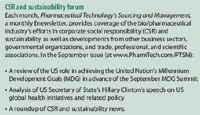Technical Forum: Small-Molecule Synthesis
Pharmaceutical Technology gains insight into approaches for producing aromatic amines.
Process chemists face the ongoing challenge of developing efficient routes for synthesizing active pharmeutical ingredients (APIs) and intermediates. Sharing approaches is helpful to resolve those challenges for specific compound classes or compounds. Pharmaceutical Technology gains a perspective from Jacobo Cruces, PhD, and chief scientifc officer of the custom-synthesis provider GalChimia (A Coruña, Spain), for approaches in synthesizing aromatic amines.
Aromatic amines
Jacobo Cruces, PhD and chief scientifc officer of the custom-synthesis provider GalChimia (A Coruña, Spain).
Aromatic amines are biologically active compounds found throughout the pharmaceutical and agrochemical industries. The development of new methods for their synthesis is still an active area of research. Especially interesting is the transformation of widely available primary anilines and heteroanilines into the corresponding secondary ones (1).

STOCKBYTE, GETTY IMAGES
Direct alkylation is typically accomplished by reaction with an alkyl halide or similar reagent in the presence of a base, but it is a deceptively simple transformation because in many cases efficient N-monoalkylation of primary anilines is not possible because of over-alkylation, which affords tertiary anilines or quaternary ammonium salts as byproducts. Other protocols for monoalkylation use a temporary protecting group (e.g., carbamate, benzyl) that allows the introduction of a single alkyl group followed by removal of the protecting group (thereby introducing two additional steps in the process). However, due to their toxic nature, the use of many of the alkylating agents must be avoided, particularly in the last step of the synthesis of APIs and active compounds. Two widely used methods of N-alkylation are reductive amination with carbonyl derivatives and amide reduction. These methods are selective, but the reaction conditions are somewhat harsh, as strong reducing reagents (i.e., metal hydrides and hydrogen) must be used, and chemoselectivity can be troublesome. Additional problems are involved during the scale-up because reducing agents are hazardous.
The formation of C–N bonds via cross-coupling reactions is an essential methodology for preparing nitrogen-containing compounds. Recently, different transition metal-promoted reactions have been developed for the synthesis of secondary amines: catalytic systems for N-alkylation of amines with alcohols using ruthenium, rhodium, or iridium catalysts based on the "borrowing hydrogen" approach (2–15). Most of these reactions must be run at high temperature (i.e., up to 180 °C) or can be applied to a restricted range of amines and alcohols. Other approaches rely on the hydroamination of alkenes or alkynes, but again in some cases, the selectivity is low or the substrate scope is not very extensive (16–21).

Figure 1: Copper-promoted alkylation of aromatic amines with alkylboronic acids. (FIGURE 1 IS COURTESY OF GALCHIMIA)
Copper-promoted carbon–nitrogen bond-forming cross-coupling reactions of NH-containing substrates with arylboronic acids have emerged as a powerful synthetic method since the initial reports by Chan, Lam and Evans (22–25). In recent years, the catalytic version of the reaction (26–28) and the arylation of amines under base and ligand-free conditions (29–31) have been reported. Although the Chan-Lam reaction has been applied to different boronic acids, alkylboronic acids rarely act as effective reagents for this reaction presumably because of their low reactivity toward transmetallation with copper salts. Until 2008, only two papers reported the use of an alkylboronic acid (cyclopropyl- and cyclohexylboronic acid) in this kind of coupling reactions with NH-containing substrates (restricted to substrates with increased NH acidity such as amides and indoles) (32–34).
GalChimia has developed a procedure for the selective N-monomethylation of aromatic amines by means of a cross-coupling reaction between anilines and methylboronic acid (35). The reaction is carried out in refluxing dioxane, and it allows a number of structurally and electronically diverse anilines to be monomethylated in a single step. The use of a copper promotor has two main advantages compared with other metal catalysts such as palladium. First, it is much cheaper than precious metals. Second, it is not a heavy metal, and it is therefore less toxic, something especially critical in the last steps of API production.

CSR and sustainability forum
Recently GalChimia expanded the previous Chan-Lam protocol to carry out the N-monoalkylation of other (hetero)aromatic amines using a wide pool of alkylboronic acids, including propyl-, iso-propyl-, butyl-, iso-butyl-, pentyl-, iso-pentyl-, cyclohexyl-, cyclohexylethyl- and phenylethylboronic acid (36). The use of phenylethylboronic acid opens a very attractive venue for the preparation of phenylethylamines, a widespread common motif among pharmacologically interesting compounds.

Patricia Van Arnum Patricia Van Arnum is a senior editor at Pharmaceutical Technology, 485 Route One South, Bldg F, First Floor, Iselin, NJ 08830 tel. 732.346.3072, pvanarnum@advanstar.com.
References
1. R.N. Salvatore, C. H. Yoon, and K.W. Jung, Tetrahedron 57 (10) 7785–7811 (2001).
2. Y. Watanabe et al., Tetrahedron Lett. 22 (28), 2667–2670 (1981).
3. Y. Watanabe et al., J. Org. Chem. 49 (18), 3359–3363 (1984).
4. Y. Watanabe et al., J. Org. Chem. 61 (13), 4214–4218 (1996).
5. C. Jun et al., Chem. Commun. 13, 1405–1406 (1998).
6. R.A.T.M. Abbenhuis, J. Boersma, and G. van Koten, J. Org. Chem. 63 (13), 4282–4290 (1998).
7 T. Naota, H. Takaya, and S.I. Murahashi, Chem. Rev. 98 (7), 2599–2660 (1998).
8. R. Grigg et al. J. Chem. Soc. Chem. Commun. 12, 611–612 (1981).
9. G. Cami Kobeci, and J.M. Williams. J. Chem. Soc. Commun., 1072–1073 (2004).
10. K.I. Fujita and R. Yamaguchi, Synlett. 4, 560–571 (2005).
11. R. Yamaguchi et al., Org. Lett. 10 (2) 181–184 (2008).
12. D. Hollmann et al., Angew. Chem. Int. Ed. 46 (43), 8291–8294 (2007).
13. A. Tillack et al., Tetrahedron Lett. 47 (50), 8881–8885 (2006).
14. K. Fujita, Y. Enoki, and R. Yamaguchi, Tetrahedron 64 (8), 1943–1954 (2008).
15. M.H Hamid et al., J. Am. Chem. Soc. 131 (5), 1766–1774 (2009).
16. T.E. Müller and M. Beller, Chem. Rev. 98 (2), 675–704 (1998).
17. M. Beller et al., Chem. Eur. J. 5 (4), 1306–1319 (1999).
18. M. Nobis and B. Driessen-Hölscher, Angew. Chem., Int. Ed. 40 (21), 3983–3985 (2001).
19. M. Utsunomiya et al., J. Am. Chem. Soc. 125 (19), 5608–5609 (2003).
20. J.S. Ryu, G.Y. Li, and T.J.J. Marks, J. Am. Chem. Soc. 125 (19), 12584–12605 (2003).
21. A.M. Johns et al., J. Am. Chem. Soc. 128 (6) 1828–1839 (2006).
22. D. Chan et al., Tetrahedron Lett. 39 (19), 2933–2936 (1998).
23. D.A. Evans, J.L. Katz, and T.R. West, Tetrahedron Lett. 39 (19) 2937–2940 (1998).
24. P.Y.S. Lam, et al., Tetrahedron Lett. 39 (19) 2941–2944 (1998).
25. P.Y.S. Lam et al., Synlett. 5, 674–676 (2000).
26. J.P. Collman and M. Zhong, Org. Lett. 2 (9), 1233–1236 (2000).
27. J.C. Antilla and S.L. Buchwald, Org. Lett. 3 (13), 2077–2079 (2001).
28. P.Y.S. Lam et al., Tetrahedron Lett. 42 (20), 3415–3453 (2001).
29. C. Moessner and C. Bolm, Org. Lett. 7 (13), 2667–2669 (2005).
30. J.B. Lan et al., Synlett. 6, 1095–1097 (2004).
31. B. Sreedhar et al., Synthesis 5, 795–799 (2008).
32. T. Tsuritaniet et al., Org. Lett. 10 (8), 1653–1665 (2008).
33. S. Bérnard, L. Neuville, and J. Zhu, J. Org. Chem. 73 (16) 6441–6444 (2008).
34. Boronic Acids, D.G. Hall, Ed., (1st Edition, Wiley-VCH, Weinheim, Germany, 2005).
35. I. González et al., Org. Lett. 11 (8) 1677–1680 (2009).
36. M. Larrosa et al., Synlett., 14, 2101–2105, (2010).

PacBio Chosen as Tech Partner for Global Alzheimer’s Disease Research Project
April 23rd 2025The project, the North African Dementia Registry, will unite multiple entities for the purpose of developing a comprehensive dataset to advance the research community’s understanding of Alzheimer’s disease and other dementias in diverse populations.
Drug Solutions Podcast: A Closer Look at mRNA in Oncology and Vaccines
April 30th 2024In this episode fo the Drug Solutions Podcast, etherna’s vice-president of Technology and Innovation, Stefaan De Koker, discusses the merits and challenges of using mRNA as the foundation for therapeutics in oncology as well as for vaccines.